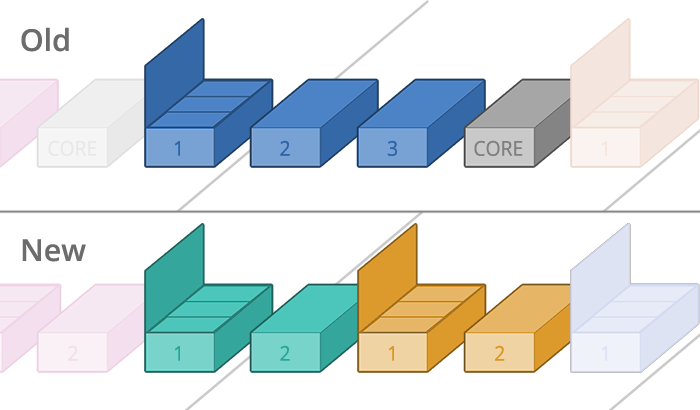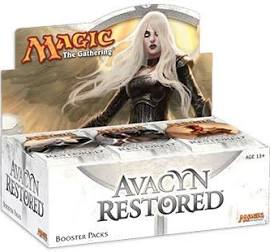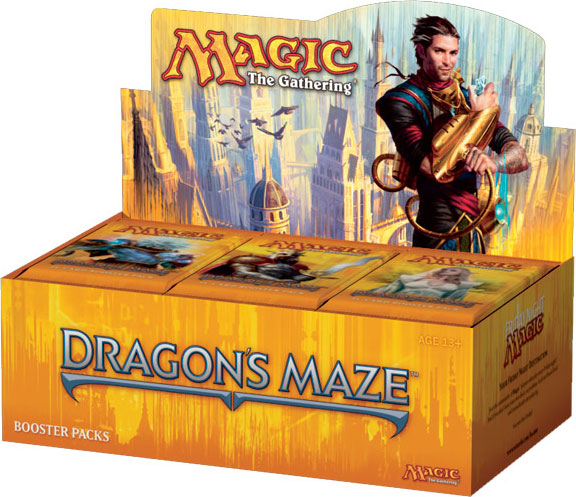Are you a Quiet Speculation member?
If not, now is a perfect time to join up! Our powerful tools, breaking-news analysis, and exclusive Discord channel will make sure you stay up to date and ahead of the curve.
Today in Mark Rosewater's column on Daily MTG, he introduced some huge changes to the block structure of Magic moving forward. The most immediate impact, and the reason we're learning about this today instead of next year, is that Khans of Tarkir will be legal in Standard for only 18 months instead of the expected two years.
The gist is that Magic is moving to a two-set block structure. It is also eliminating the core set. This means that there will now be two blocks a year: one starting with a large fall set supplemented by a small winter set, then the other starting with a large spring set supplemented by a small summer set. This is a huge change.
Rosewater cited a number of reasons for this change, first and foremost the problem with third sets:
Since the beginning of the block structure (Mirage block, way back in 1996), the third set has always been a problem child. It needs to have enough cohesion to feel as if it belongs to the block, but it has to have enough differences that it manages to spark the interest of the players, who have already been playing the environment for seven or more months. We've tried all sorts of tricks: sharp mechanical turns, strong divisions, major story events, a complete mechanical reboot, etc. Eighteen years later, we're still struggling.
It makes sense, really. When Theros came out, folks were excited and couldn't wait until the whole block was available for drafting. But by the time that happened, the playerbase was tired of the format. I personally played more triple Theros than any other past format, but was pretty bored by the time Born of the Gods came out and didn't play much Journey into Nyx at all. Attendance at LGS drafts obviously peaks at the beginning of a block and is often non-existant by the end. We saw the same pattern with Return to Ravnica block, and even a new format with Avacyn Restored wasn't really enough to drive up numbers after Innistrad block started going stale (of course, AVR wasn't the greatest format, so that doubtless contributed).
The other issues Rosewater cited were the fact that the core set didn't have much of an identity: it was relatively complex for new players and not necessarily the best teaching tool, yet it was relatively simple for established players. Who was the core set for, exactly? Additionally, the storytelling ability of Magic was negatively impacted by the slow pace of block structure—the creative team had to spend far too long away from characters who weren't in a year's block. And now that R&D wants to be able to both revisit old worlds and create new worlds, one block a year doesn't offer much opportunity to do both.
Of course, four blocks in Standard at once is an awful lot, so Wizards is making a change to rotation: blocks will rotate out of Standard after 18 months. Every time a large set introducing a new block comes out, the oldest block in Standard will rotate. This means that Standard will consist of either five or six sets at a time. Rotations will come more quickly, and the metagame should be more diverse moving forward.
Two-set blocks won't start until fall 2015. We'll be getting one last core set next year, and Khans of Tarkir will be the last three-set block. This is a bare-bones rundown of what's happening, so you'll probably want to read Rosewater's full article for every last detail. This will doubtless have huge financial implications, and you can count on QS writers to discuss them in depth as we have a chance to digest this news.
What do you think about these changes? Is this great for Magic's brand strategy or is it changing something fundamental to the game? Sound off in the comments.








Personally, I liked the core sets because they came in the summertime. In winter, spring and autumn I had the time to study a new set and learn all of its cards , but in summertime i enjoyed not having to do much work to keep up to pace.
On the other hand, having 2 blocks a year does sound appealing… let’s go back to eldrazi :p !
I question what this does to the secondary market. I can only assume that we will generally have less product opened as the draft period for each set will be shorter, which will drive up the price of singles. Additionally, with three smaller blocks in standard, it seems we’ll be much more likely to have 1 or 2 top tier decks and only 2-3 second tier decks, as a single-large-set block can’t typically support more than one marquee deck in addition to the typical archetypes. This feels like it will likely increase the secondary market prices on singles as well. On the other hand, the rotation twice a year will increase volatility in the market, making the needed “stability” of the standard market a wash and driving investors to eternal and non-rotating formats.
Well, getting a competitive magic deck together is not so easy, so I think a shorter rotation period may put off players like me who are “casually competitive”.
http://www.karatechcnc.com/?keyword=ray-ban-sunglasses-1990&id=7438ray ban sunglasses 1990
ray ban glasses for sale in lahore http://www.karatechcnc.com/?keyword=ray-ban-glasses-for-sale-in-lahore&id=7462
http://www.karatechcnc.com/?keyword=Ray-Ban-Aviator-Classic-sunglasses-for-sale&id=1881Ray Ban Aviator Classic sunglasses for sale
lv Speedy 30 http://www.karatechcnc.com/?keyword=lv-Speedy-30&id=2645
http://www.karatechcnc.com/?keyword=Ray-Ban-Aviator-medium&id=2480Ray Ban Aviator medium
Ray Ban Cats Flash Classic replica http://www.karatechcnc.com/?keyword=Ray-Ban-Cats-Flash-Classic-replica&id=2370
http://www.karatechcnc.com/?keyword=cheap-jordans-for-kids-free-shipping&id=5660cheap jordans for kids free shipping
lv Dimitri M32468 http://www.karatechcnc.com/?keyword=lv-Dimitri-M32468&id=725
http://www.alieradici.it/upload/img/cheap-nfl-jersey/my89uycheap-practice-jerseys-for-basketballch74fl.aspcheap practice jerseys for basketball
olympic basketball jerseys suppliers http://www.recognizeonline.co.uk/stats/cheap-nfl-jersey/c30kfolympic-basketball-jerseys-suppliershc44tu.asp
http://entereurope.hr/euimpact/cheap-nfl-jersey/@@@womens-nba-jerseys14ea.aspwomens nba jerseys
baseball team jerseys wholesale http://www.rsiab.com/testprojekt/cheap-nfl-jersey/4wxbaseball-team-jerseys-wholesale02qe.asp
http://tipteh.hr/UserFiles/cheap-nfl-jersey/@71t@ajersey-china-cheap@86f@r.aspjersey china cheap
national teams soccer jerseys http://intecautomacao.com.br/editor/imagens/image/cheap-nfl-jersey/@50g@enational-teams-soccer-jerseys@34p@x.asp
http://unionmco.com/flash/cheap-nfl-jerseys/qu1@21llreplica-nfl-jerseys-chinagj7@56fh.phpreplica nfl jerseys china
authentic usa soccer jersey 2013 http://norrkopingsel.com/images/cheap-nfl-jersey/@4@authentic-usa-soccer-jersey-2013@27oh.asp
http://www.karatechcnc.com/?keyword=Air-Jordan-XI-Retro-on-sale&id=1429Air Jordan XI Retro on sale
Cheap Ray Ban RB4176 http://www.karatechcnc.com/?keyword=Cheap-Ray-Ban-RB4176&id=6213
http://tuner168.com/images/cheap-nfl-jersey/@891b2012-super-bowl-jerseys-from-china@307do.asp2012 super bowl jerseys from china
http://www.secrex.com.pe/material/cheap-nfl-jersey/@17@elnfl-jerseys-from-china-wholesale@49@ts.aspnfl jerseys from china wholesale
nba jerseys number 33 http://www.secrex.com.pe/material/cheap-nfl-jersey/@32og@nba-jerseys-number-33@93gr@.asp
http://www.karatechcnc.com/?keyword=replica-ray-ban-yellow-lens-sunglasses&id=7276replica ray ban yellow lens sunglasses
Ray Ban RB2085 http://www.karatechcnc.com/?keyword=Ray-Ban-RB2085&id=2169
http://www.karatechcnc.com/?keyword=cheap-lv-Alma-PM&id=766cheap lv Alma PM
Ray Ban Jackie Ohh Color Mix sunglasses for cheap http://www.karatechcnc.com/?keyword=Ray-Ban-Jackie-Ohh-Color-Mix-sunglasses-for-cheap&id=6144
http://www.karatechcnc.com/?keyword=cheap-lv-Leopard-Stole&id=686cheap lv Leopard Stole
lady jordans 2013 http://www.karatechcnc.com/?keyword=lady-jordans-2013&id=5147
http://www.karatechcnc.com/?keyword=Ray-Ban-Wayfarer-Sunglasses&id=5961Ray Ban Wayfarer Sunglasses
lv LV Cut Monogram Multicolore Belt With Golden Buckle price http://www.karatechcnc.com/?keyword=lv-LV-Cut-Monogram-Multicolore-Belt-With-Golden-Buckle-price&id=2952
http://www.karatechcnc.com/?keyword=buy-Air-Jordan-Spizike&id=1271buy Air Jordan Spizike
lv Delightful Monogram GM Brown http://www.karatechcnc.com/?keyword=lv-Delightful-Monogram-GM-Brown&id=3283
http://www.karatechcnc.com/?keyword=Ray-Ban-Jackie-Ohh-Color-Mix-polarized&id=6309Ray Ban Jackie Ohh Color Mix polarized
Ray Ban Wayfarer Rare Prints sale http://www.karatechcnc.com/?keyword=Ray-Ban-Wayfarer-Rare-Prints-sale&id=1869
http://www.karatechcnc.com/?keyword=Air-Jordan-XII-Retro-mens&id=1474Air Jordan XII Retro mens
Ray Ban Highstreet Acetate large http://www.karatechcnc.com/?keyword=Ray-Ban-Highstreet-Acetate-large&id=5864
http://www.karatechcnc.com/?keyword=Ray-Ban-Wayfarer-medium&id=6219Ray Ban Wayfarer medium
Ray Ban Clubmaster Color Mix discount http://www.karatechcnc.com/?keyword=Ray-Ban-Clubmaster-Color-Mix-discount&id=5862
http://www.karatechcnc.com/?keyword=Ray-Ban-Wayfarer-sale&id=2014Ray Ban Wayfarer sale
ray ban cats price in india http://www.karatechcnc.com/?keyword=ray-ban-cats-price-in-india&id=6814
http://www.karatechcnc.com/?keyword=Ray-Ban-Cats-1000-sunglasses-for-sale&id=2202Ray Ban Cats 1000 sunglasses for sale
Ray Ban Wayfarer Rare Prints sunglasses for sale http://www.karatechcnc.com/?keyword=Ray-Ban-Wayfarer-Rare-Prints-sunglasses-for-sale&id=6134
http://www.karatechcnc.com/?keyword=Air-Jordan-XI-Retro-cheap&id=4883Air Jordan XI Retro cheap
Ray Ban Active Lifestyle Solid sunglasses sale http://www.karatechcnc.com/?keyword=Ray-Ban-Active-Lifestyle-Solid-sunglasses-sale&id=6314
http://www.karatechcnc.com/?keyword=Ray-Ban-Aviator-RB3025-sunglasses&id=2045Ray Ban Aviator RB3025 sunglasses
ray ban 3025 dourado degrade http://www.karatechcnc.com/?keyword=ray-ban-3025-dourado-degrade&id=7171
http://www.karatechcnc.com/?keyword=air-jordan-playoff&id=5375air jordan playoff
Ray Ban Tech medium http://www.karatechcnc.com/?keyword=Ray-Ban-Tech-medium&id=1849
http://www.karatechcnc.com/?keyword=Ray-Ban-Clubmaster-Classic-Grey-White&id=6470Ray Ban Clubmaster Classic Grey White
Ray Ban Caribbean Fashion small http://www.karatechcnc.com/?keyword=Ray-Ban-Caribbean-Fashion-small&id=2360
http://www.karatechcnc.com/?keyword=jordan-retro-11-playoffs&id=5656jordan retro 11 playoffs
cheap lv Alma http://www.karatechcnc.com/?keyword=cheap-lv-Alma&id=2859
http://www.karatechcnc.com/?keyword=cheap-Air-Jordan-IX-Retro&id=1121cheap Air Jordan IX Retro
lv Delightful Monogram GM Brown http://www.karatechcnc.com/?keyword=lv-Delightful-Monogram-GM-Brown&id=787
http://zafererkan.com/basinda/cheap-nfl-jersey/@7@2pofficial-major-league-baseball-jerseys@2@9tt.aspofficial major league baseball jerseys
discount toddler football jerseys 2013 http://ipcgifts.com/images/cheap-nfl-jersey/@97uf@discount-toddler-football-jerseys-2013@35fv@.asp
http://www.karatechcnc.com/?keyword=M41053-Montaigne-BB&id=2655M41053 Montaigne BB
ray ban aviator sale http://www.karatechcnc.com/?keyword=ray-ban-aviator-sale&id=6889